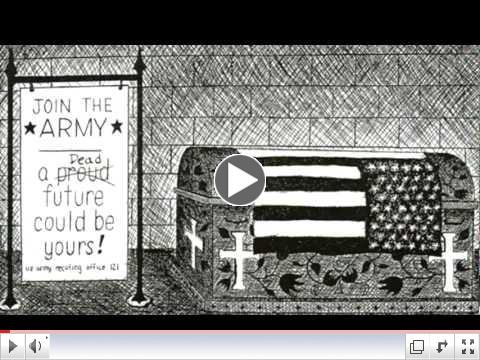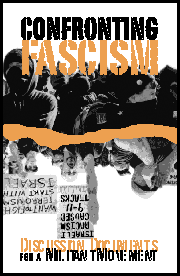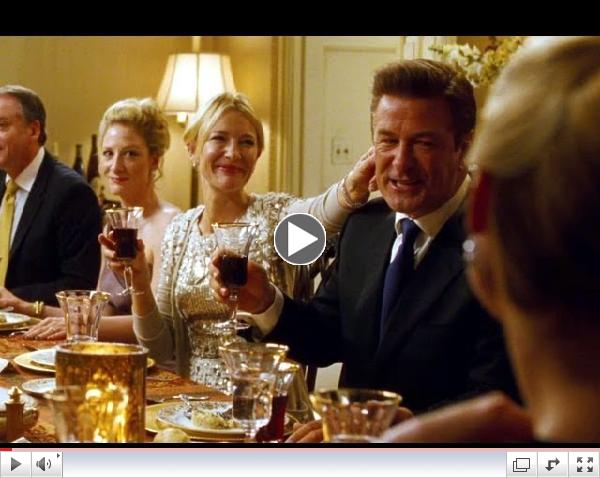|
Quick Links...
CCDS Discussion |
 The new annual edition of our journal of discussion and analysis is now out. More than 130 pages, it includes 20 articles on organizing, racism and the right. Cost is $10 plus shipping. Or get one by becoming a sustainer. Click the title to buy it directly. The new annual edition of our journal of discussion and analysis is now out. More than 130 pages, it includes 20 articles on organizing, racism and the right. Cost is $10 plus shipping. Or get one by becoming a sustainer. Click the title to buy it directly.
|
New Issue of Mobilizer

Check out what CCDS has been doing...
|

Edited by Carl Davidson Revolutionary Youth the the New Working Class: The Praxis Papers, the Port Authority Statement, the RYM Documents and other Lost Writings of SDS
Changemaker, 273pp, $22.50
For the full contents, click the link and view 'Preview' under the cover graphic.
|
|
By Randy Shannon, CCDS

"Everyone has the right to work, to free of employment, to just and favorable conditions of work and to protection against unemployment."
- United Nations Universal Declaration of Human Rights, December 10, 1948
I. Introduction
The "Great Recession" that began in 2007 has caused the greatest percent of job losses since the Great Depression of 1929. This crisis is the end of an era of unrestrained 'neo-liberal' capitalism that became public policy during the Reagan administration. The crisis marks a new level of instability with the growth of a global financial elite that targeted US workers and our trade unions after World War II.
|
|
Order Our
Full Employment Booklets
 |
...In a new and updated 2nd Edition
Capitalism may well collapse under its own excesses, but what would one propose to replace it? Margaret Thatcher's mantra was TINA...There Is No Alternative. David Schweickart's vision of "Economic Democracy" proposes a serious alternative. Even more fundamentally, it opens the door to thinking about alternatives. His may or may not turn out to be the definitive "successor system," but he is a leader in breaking out of the box. |
We Are Not What We Seem:
Black Nationalism and Class Struggle in the American Century
By Rod Bush, NYU Press, 1999
|
 A Memoir of the 1960s A Memoir of the 1960s
by Paul KrehbielAutumn Leaf Press, $25.64 | | Shades of Justice Video: Bringing Down a President, Ending a War |
|

Essays on Mondragon, Marx, Gramsci
and the Green and Solidarity Economies |
Solidarity Economy:What It's All About

Edited by Jenna Allard, Carl Davidson and Julie Matthaei
Buy it here...
|

- Foreword by Susan Brownmiller
- Preface by Ken Wachsberger
$37.50 + $6 shipping
|
|
Discussion Documents for a Militant Movement

By Don Hamerquist
|
|
|
|
An Invitation to CCDSers and Friends...
 Cracks Spreading in 'White United Front'
We're the Committees of Correspondence for Democracy and Socialism...Do you have friends who should see this? Pass it on...Do you have a blog of your own? Others you love to read every day? Well, this is a place where you can share access to them with the rest of your comrades. Just pick your greatest hits for the week and send them to us at carld717@gmail.com!
Most of all, it's urgent that you defend voter rights, plan for 2014 races now, oppose austerity, support the 'Moral Mondays' in North Carolina (photo above), the Congressional Progressive Caucus' 'Back to Work Budget' and end the wars! We're doing more than ever, and have big plans. So pay your dues, make a donation and become a sustainer. Do it Now! Check the link at the bottom...
|
New Survey: 80 Percent Of U.S. Adults
Face Near-Poverty, Unemployment

By HOPE YEN
Huffington Post
July 28, 2013, WASHINGTON - Four out of 5 U.S. adults struggle with joblessness, near-poverty or reliance on welfare for at least parts of their lives, a sign of deteriorating economic security and an elusive American dream.
Survey data exclusive to The Associated Press points to an increasingly globalized U.S. economy, the widening gap between rich and poor, and the loss of good-paying manufacturing jobs as reasons for the trend.
The findings come as President Barack Obama tries to renew his administration's emphasis on the economy, saying in recent speeches that his highest priority is to "rebuild ladders of opportunity" and reverse income inequality.
As nonwhites approach a numerical majority in the U.S., one question is how public programs to lift the disadvantaged should be best focused - on the affirmative action that historically has tried to eliminate the racial barriers seen as the major impediment to economic equality, or simply on improving socioeconomic status for all, regardless of race.
Hardship is particularly growing among whites, based on several measures. Pessimism among that racial group about their families' economic futures has climbed to the highest point since at least 1987. In the most recent AP-GfK poll, 63 percent of whites called the economy "poor."
"I think it's going to get worse," said Irene Salyers, 52, of Buchanan County, Va., a declining coal region in Appalachia. Married and divorced three times, Salyers now helps run a fruit and vegetable stand with her boyfriend but it doesn't generate much income. They live mostly off government disability checks.
"If you do try to go apply for a job, they're not hiring people, and they're not paying that much to even go to work," she said. Children, she said, have "nothing better to do than to get on drugs."
While racial and ethnic minorities are more likely to live in poverty, race disparities in the poverty rate have narrowed substantially since the 1970s, census data show. Economic insecurity among whites also is more pervasive than is shown in the government's poverty data, engulfing more than 76 percent of white adults by the time they turn 60, according to a new economic gauge being published next year by the Oxford University Press....(Click title for more)
|
|

By Bob Wing*
via Online University of the Left
[*Bob Wing has been a social justice organizer and writer since 1968. He was the founding editor of ColorLines magazine and War Times newspaper. Bob lives in Durham, NC and can be contacted through Facebook. Special thanks to my lifelong colleagues Max Elbaum and Linda Burnham and to Jon Liss, Lynn Koh, Carl Davidson, Ajamu Dillahunt, Raymond Eurquhart and Bill Fletcher, Jr. for their comments, critiques and suggestions.]
August 1, 2013 - The heartless combination of the Supreme Court's gutting of the Voting Rights Act, the House Republicans flatly shunning the immigration bill and the Trayvon Martin outrage should be a wake up call about the grave dangers posed by the far right and may give rise to a renewed motion among African Americans that could give much needed new impetus and political focus to the progressive movement.
The negative policies and missteps of the Obama administration are often the target of progressive fire, and rightly so. But these take place in the context of (and are sometimes caused by) an extremely perilous development in U.S. politics: an alliance of energized rightwing populists with the most reactionary sector of Big Business has captured the Republican Party with "the unabashed ambition to reverse decades of economic and social policy by any means necessary." (1)
The GOP is in all-out nullificationist mode, rejecting any federal laws with which they disagree. They are using their power in the judiciary and Congress to block passage or implementation of anything they find distasteful at the federal level. And under the radar the Republicans are rapidly implementing a far flung rightwing program in the 28 states they currently control. They have embarked on an unprecedented overhaul of government on behalf of the one percent and against all sectors of the poor and much of the working and middle classes, undermining the rights of all.
The main precedent in U.S. history for this kind of unbridled reactionary behavior was the states rights, pro-slavery position of the white South leading up to the Civil War. Dr. Martin Luther King, Jr. called out the attempts at nullification in his famous "I Have a Dream Speech," and the movement of the sixties defeated it. As shown in the ultra-conservative playground that is the North Carolina legislature, the new laws and structures of today's rightwing program are so extreme and in such stark contrast to the rest of the country that I believe both their strategy and their program should be called "Neo-Secession."
This nullification and neo-secession must be met by a renewed motion for freedom and social justice. The great scholar-activist Manning Marable, the leader of the powerful fightback in North Carolina NAACP President Rev. William Barber II, MSNBC's Melissa Harris-Perry and others have called for a Third Reconstruction that builds on the post-Civil War first Reconstruction and the Civil Rights/Second Reconstruction. (2)
We are now at a pivotal point in this fight. The battlelines are drawn: Reactionary Nullification and Neo-Secession or Third Reconstruction?...(Click title for more)
|

By Chauncey DeVega
Alternet via Daily KOS
August 1, 2013 - NBC's recent story on how 80 percent of Americans will be living at or near the poverty level [3] in their lifetimes was accompanied by the above photo of a "poor white family".
The heart of the the AP's report on the (further) economic imperilment of the American people is focused on the rise in "white poverty", and the struggles faced by the "white working class" in the time of the Great Recession.
Images that feature human beings "work" in communicating political and social meaning because of how the viewer "reads" them. As such, there are stated and unstated assumptions which the person who is "seeing" applies to the "object" of their gaze.
For example, the White Gaze views a photo of a young black man wearing a hoodie and whose pants are sagging and sees a person who exists in a state of criminality, and is a social predator.
A photo of a white man wearing a suit and walking down Wall Street in New York will be seen by the White Gaze as representing a "respectable" person and a "hard worker" living the "American Dream."
In reality, the former may be on the way to his 3rd job, has never been in prison or arrested, and takes care of his aged parents and siblings. The latter could be a child-molesting murderer and rapist, who is also embezzling millions of dollars from his clients.
White and male--and Whiteness more generally--views itself as benign and harmless. Black and male--and Blackness more generally--is viewed by White American society as dangerous and pathological. The power of images is how they harness and channel assumptions about how various types of personhood find representation in, and are configured by, a broader system of dominance, subordination, privilege, inclusion, exclusion, and hierarchy.
NBC.com's photo is an example of those processes at work. There we "see" two overweight white women with a young child, and thus make social and political assumptions about gender and class. We see a small home and generalize from that visual about how "poor people" live, and more importantly, "what type of people" they are.
Images also give the viewer permission to empathize or to condemn the subject. Are these "good" people or "bad people?" What is my sense of obligation to them? Does my sense of community extend to people like them?...(Click title for more)
|
Four Decades after War, Agent Orange
Still Ravaging the Vietnamese People

U.S. war veteran Larry Vetter conducts physical therapy exercises with 18-year-old La Thanh Nghia, near Da Nang, Vietnam. Nghia and his brother Toan, 21, are third generation Agent Orange victims, the result of the U.S. military's use of Agent Orange and other herbicides during the Vietnam War more than 40 years ago.
By Drew Brown Miami Herald via McClatchy
July 23, 2013 - In many ways, Nguyen Thi Ly is just like any other 12-year-old girl. She has a lovely smile and is quick to laugh. She wants to be a teacher when she grows up. She enjoys skipping rope when she plays.
But Ly is also very different from other children. Her head is severely misshapen. Her eyes are unnaturally far apart and permanently askew. She's been hospitalized with numerous ailments since her birth.
Her mother, 43-year-old Le Thi Thu, has similar deformities and health disorders. Neither of them has ever set foot on a battlefield, but they're both casualties of war.
Le and her daughter are second- and third-generation victims of dioxin exposure, the result of the U.S. military's use of Agent Orange during the Vietnam War, when the U.S. Air Force sprayed more than 20 million gallons of Agent Orange and other herbicides over parts of southern Vietnam and along the borders of neighboring Laos and Cambodia. The herbicides were contaminated with dioxin, a deadly compound that remains toxic for decades and causes birth defects, cancer and other illnesses.
To this day, dioxin continues to poison the land and the people. The United States has never accepted responsibility for these victims - it denies that Agent Orange is responsible for diseases among Vietnamese that are accepted as Agent Orange-caused among American veterans - and it's unclear when this chain of misery will end.
On Thursday, President Barack Obama will meet with Vietnamese President Truong Tan Sang at the White House, only the third meeting between chief executives of the two countries since Vietnam and the United States established diplomatic relations in 1995.
The two countries share many contemporary concerns. The White House says Obama plans to discuss cooperation on regional issues and trade, plus other U.S. priorities such as climate change and human rights. The two countries share a strong common interest in countering China, which has become increasingly assertive over potentially oil-rich areas of the South China Sea.
Many Vietnamese say it's time for the United States to do more to address the issue of Agent Orange and its victims, so that the last tragic chapter of the Vietnam War finally can be closed.
Le Thi Thu's father served in the North Vietnamese army and was wounded in Quang Tri province, one of the most heavily sprayed areas of the country.
"Before he went to war, my father had two children: my older brother and sister," said Le, who was born in 1970. "They were normal. But after he came back, he had me."
"I could see the differences in myself and others right away," she recalled. "When I was a small child, I felt pain inside my body all the time. My parents took me to the hospital, and the doctors determined that I had been affected by Agent Orange."...(Click title for more)
|
|
Part One: It's Not About the Climate
By Michael Shellenberger & Ted Nordhaus
SolidarityEconomy.net via TheBreakthough.org
April 29, 2013 - Over the last few decades, humans achieved one of the most remarkable victories for social justice in the history of the species. The percentage of people who live in extreme poverty - under $1.25 per day - was halved between 1990 and 2010. Average life expectancy globally rose from 56 to 68 years since 1970. And hundreds of millions of desperately poor people went from burning dung and wood for fuel (whose smoke takes two million souls a year) to using electricity, allowing them to enjoy refrigerators, washing machines, and smoke-free stoves.
Of course, all of this new development puts big pressures on the environment. While the transition from wood to coal is overwhelmingly positive for forests, coal-burning is now a major contributor to global warming. The challenge for the twenty-first century is thus to triple global energy demand, so that the world's poorest can enjoy modern living standards, while reducing our carbon emissions from energy production to zero.
For the last 20 years, most everyone who cared about global warming hoped for a binding international treaty abroad, and some combination of carbon pricing, pollution regulations, and renewable energy mandates at home. That approach is now in ruins. In 2010, UN negotiations failed to create a successor to the failed Kyoto treaty. A few months later cap and trade died in the Senate. And two weeks ago, the slow motion collapse of the European Emissions Trading Scheme reached its nadir, with carbon prices, already at historic lows, collapsing after EU leaders refused to tighten the cap on emissions.
What rushed into the vacuum was "climate justice," a movement headed by left-leaning groups like 350.org, the Sierra Club, and Greenpeace. These groups invoke the vulnerability of the poor to climate change, but elide the reality that more energy makes them more resilient. "Huge swaths of the world have been developing over the last three decades at an unprecedented pace and scale," writes political scientist Christopher Foreman in "On Justice Movements," a new article for Breakthrough Journal. "Contemporary demands for climate justice have been, at best, indifferent to these rather remarkable developments and, at worst, openly hostile."
For the climate justice movement, global warming is not to be dealt with by switching to cleaner forms of energy, but rather by returning to a pastoral, renewable-powered, and low-energy society. "Real climate solutions," writes Klein, "are ones that steer these interventions to systematically disperse and devolve power and control to the community level, whether through community-controlled renewable energy, local organic agriculture, or transit systems genuinely accountable to their users..."
Climate change can only be solved by "fixing everything," says McKibben, from how we eat, travel, produce, reproduce, consume, and live. "It's not an engineering problem," McKibben argued recently in Rolling Stone. "It's a greed problem." Fixing it will require a "new civilizational paradigm," says Klein, "grounded not in dominance over nature, but in respect for natural cycles of renewal."
Climate skeptics are right, Klein cheerily concludes: the Left is using climate change to advance policies they have long wanted. "In short," says Klein, "climate change supercharges the pre-existing case for virtually every progressive demand on the books, binding them into a coherent agenda based on a clear scientific imperative." ...(Click title for more)
|
Books: On Aaron Lecklider's
'Inventing the Egghead'

By Evan Kindley ThePointMag.com
Is America anti-intellectual? The jury is still out.
One could make equally plausible cases for our country as a hotbed of hostility to organized intelligence and as a sort of paradise for the cleverest, a place that elevates intellectual sophistication (especially when it has economic or technological applications) above basic moral decency.
We oscillate wildly between demonizing our intellectuals and deifying them; they appear to us, in turn, as nuisances, threats, and saviors. We cut their funding and then study how their brains function. We trust them with our economy, our climate, our media and our institutions, then rage against them for their failures-and then trust them all over again.
Of course, much depends on what is meant by "intellectual." The term, which originated in France and entered the English language around the time of the Dreyfus Affair, is notoriously vague and unstable. Though in its most neutral sense it describes only a tendency toward speculative thought, it is very quickly made into a social category with determinate characteristics.
Put a novelist, a philosopher, a physicist, a political analyst and a computer programmer in a room together and they're likely to discover as many differences as similarities-provided they can understand each other at all-but all can be identified (for ease of condemnation, if nothing else) under this single heading. The very notion of "the intellectual" depends on the idea that, over and above what particular people happen to know or do, there is a social category that we can enshrine, or hold culpable. Like the notion of "the aristocrat" that it has in some ways replaced, the intellectual provides a screen on which to project aspiration and hatred, idealism and cynicism.
In Inventing the Egghead: The Battle over Brainpower in American Culture, the cultural historian Aaron Lecklider explores how "Americans who were not part of the traditional intellectual class negotiated the complicated politics of intelligence within an accelerating mass culture." Here he follows the Italian Marxist critic Antonio Gramsci, who theorized a distinction between "traditional" (bourgeois) and "organic" (working-class) intellectuals, as well as in the vein of British cultural historians Richard Hoggart (The Uses of Literacy) and Raymond Williams (The Long Revolution). Against the received idea, which he associates with historians like Richard Hofstadter and Christopher Lasch, that "the masses" have always been reflexively anti-intellectual, Lecklider argues that, throughout the twentieth century, intelligence-or "brainpower," as he prefers to say-was in fact highly valued by working-class people in a variety of contexts.
Lecklider's agenda is a broadly populist one: he wants to defend the American working class from allegations of anti-intellectualism, and to redescribe what might look like hostility or resentment as a form of fascinated engagement. His story begins around the turn of the century, with what he calls a "mainstreaming of intelligence": a mass movement, mediated by popular culture, to devalue traditional intellectuals and promote organic ones. "Cultural texts consumed by millions of ordinary men and women between 1900 and 1960 suggested all Americans were intellectually gifted," Lecklider writes, "while deflating the presumptuous grandstanding of the traditional intellectual elite." (In this, organic intellectuals have not operated so differently from traditional intellectuals, who have never been above undermining the stature of others in order to build up their own.)
In the book's compelling first chapter, Lecklider discusses the attempts of Coney Island theme parks like Dreamland and Luna Park to bolster their educational aspects. (Dreamland, for instance, hosted the experimental baby incubators of Dr. Martin A. Couney in 1903, and in 1909 Luna Park was "disrobed of its sugar coating" and became the Luna Park Institute of Science.) At around the same time, the Chautaqua circuit, a 1904 extension of the popular adult-education gatherings held as far back as 1874 in upstate New York, provided a sort of fin-de-siècle equivalent to today's TED Talks. Chautaqua lectures, described by Theodore Roosevelt as "the most American thing in America," were held on topics of political and scientific interest, with speakers ranging from William Jennings Bryan to Mascot the educated horse. "Audiences for the Chautauquas were comprised of women and men without any particular standing as intellectuals or claims to expertise," Lecklider writes, "and though they were occasionally glossed with the narrative sheen of social uplift, the assembly programs were designed to offer education to undistinguished audiences and to imbue mass culture with a gleam of shimmering smartness." At the same time, brainpower was being valorized and mobilized by working-class labor organizers, and by African-American leaders involved in the 1920s "New Negro" movement....(Click title for more)
|
By Mike LaSalle
SFGate
 Drama. Starring Cate Blanchett, Sally Hawkins, Alec Baldwin and Andrew Dice Clay. Directed by Woody Allen. (PG-13. 98 minutes.) Drama. Starring Cate Blanchett, Sally Hawkins, Alec Baldwin and Andrew Dice Clay. Directed by Woody Allen. (PG-13. 98 minutes.)
"Blue Jasmine" represents another leap forward for Woody Allen. This would hardly seem possible. He has been making movies for more than four decades and is responsible for more classics than any other writer-director in history, with the exception of his idol, Ingmar Bergman. But in its tonal range and in the depth of its lead character, "Blue Jasmine" is something new.
When we talk about tone in movies, we're talking about the breadth of elements that can be shown within a story without jarring the established reality. Life itself has no tone - life is big enough for everything. But a work of art is limited. Constraints are put in place, so that soon it's understood, by the viewer, that certain kinds of things fit, and others don't.
 | | Blue Jasmine - Trailer: Cate Blanchett, Alec Baldwin |
The beauty of "Blue Jasmine" is that, tonally, it's almost as big as life. Allen harmonizes what is essentially a deadly serious story with the ever-present possibility of humor, without diminishing the truth or effectiveness of either. And he accomplishes this with such assurance, fluidity and seamlessness that we barely notice the virtuosity at work.
When we first meet Jasmine (Cate Blanchett), she is on an airplane gabbing away at her captive seat partner (Joy Carlin), and the situation is comical. Here is a clueless woman, but elegant and clearly well-off, and the expectation - born of having seen other Allen movies - is we're going to be watching Jasmine the way we watched, say, Penelope Cruz in "Vicky Cristina Barcelona," from an appreciative distance. We don't expect to be plunged directly into the center of this woman's pain.
But soon we are, and this is what makes Jasmine different from Allen's other heroines. Though he has been rightly praised for writing strong women's roles, his women are generally seen from a man's perspective - albeit a man who is brilliant, sympathetic and observant. Jasmine is something else. She is someone we discover from the inside, and she is of epic scale, a creation worthy of a great writer. She is Woody Allen's Blanche DuBois.
As we soon see, Jasmine is in trouble. Her husband, a New York financier, was this movie's equivalent of Bernard Madoff. Now the boats, the cars, the houses and the jewelry are gone, and Jasmine has fled New York for San Francisco, where she is to stay with her working-class sister (Sally Hawkins) until she gets on her feet. In the meantime, she is drinking heavily, self-medicating with pills and still can't shake a belief in her own entitlement.
"Blue Jasmine" alternates the present-day scenes with scenes of Jasmine's previous life of splendor, a splendor leavened only by a slight suspicion of something shady behind all the wealth. Jasmine didn't deserve to live the way as she did, but her fall from grace is nonetheless hard, and to see her on a double date with her sister's uncouth friends is to root for her to find her way back to some kind of prosperity....(Click title for more)
|
|
Become a CCDS member today!
 The
time is long past for 'Lone Rangers'. Being a socialist by your self is
no fun and doesn't help much. Join CCDS today--$36 regular, $48
household and $18 youth. The
time is long past for 'Lone Rangers'. Being a socialist by your self is
no fun and doesn't help much. Join CCDS today--$36 regular, $48
household and $18 youth.
Better yet, beome a sustainer at $20 per month,
and we'll send you a copy of Jack O'Dell's new book, 'Climbing Jacobs
Ladder,' drawing on the lessons of the movement in the South in the
1950s and 1960s.
Solidarity, Carl Davidson, CCDS |
|
|